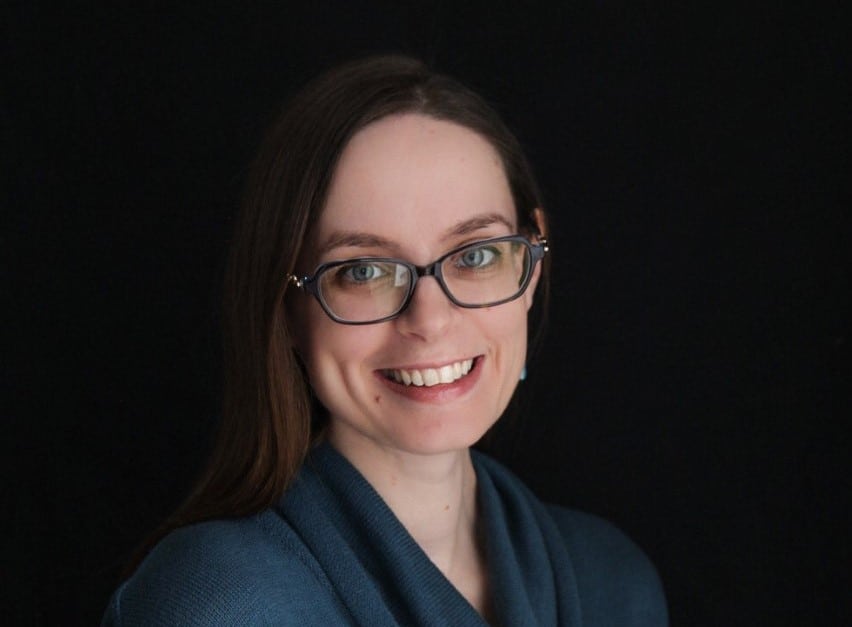Two heads may be better than one, except when they collide.
And it was just such a head bump that sent young mother Angela Davenport of Bellingham, Washington on a two-year quest for relief from troubling concussion symptoms – a journey that eventually ended between the pages of a book and a hope-filled visit to the Mind-Eye Institute in Northbrook, Ill.
“For two years, I had been unable to think clearly; experienced headaches all day long; could not envision the future, plan, or schedule; oftentimes could not understand what my children were saying or asking me; and had difficulty reading, especially words on a computer screen. Then my mother told me about a book,” Angela relates.
Not just any book, but a book that directed Angela to Deborah Zelinsky, OD, founder of, and now executive director for research at, the Mind-Eye Institute. Published in 2015, The Ghost in My Brain was written by DePaul University Chicago professor Clark Elliott, Ph.D. In it, the author details his own eight-year search for answers following a traumatic brain injury in a car crash. His search ended at the Mind-Eye Institute and at Designs for Strong Minds, which is led by cognitive restructuring specialist Donalee Markus in Highland Park, Ill.
“Because of my head injury, I could read the book only in small chunks, but the more I read, the more convinced I became that my visual processing capabilities – the ability to visualize thoughts – was what was missing in me. I became so emotional, I skipped to the end of the book [to learn how Dr. Elliott’s problems resolved],” Angela recalls.
The Mind-Eye team has achieved worldwide recognition for the use of therapeutic eyeglasses, lenses, prisms, and filters to vary the amount, intensity and angle of light that passes through the retina. The retina is part of the central nervous system and a primary portal through which information enters the brain in the form of light-generated electrical signals.
“By manipulating light, we are often able to lessen symptoms and restore comfort to patients needing to rebuild visual processing skills compromised by brain injury, head trauma, stroke, and other neurological disorders,” says Carla Adams, OD, Angela’s optometrist. “Our unique optometric testing and approach also help in developing new processing capabilities in patients with attention and other learning deficiencies.”
Angela’s injury occurred when her 5-year-old son unexpectedly jumped up while she was getting him ready for church, knocking his head into hers. “My first thought was to wonder whether I had just sustained a concussion. I quickly realized something was wrong because, when we arrived at church, I was unable to see the hymnal pages clearly. I thought the problem might be minor, and a couple days of rest would eliminate it.”
But those “couple days” came and went, and Angela’s symptoms devolved into constant headaches, nausea, motion sickness so serious that she found traveling in a car for more than 10 minutes almost unbearable – “I had to close my eyes to prevent seeing the outside scenery whiz past me,” difficulty in understanding and participating in conversation, balance problems, occasional slurred or garbled speech, and extreme fatigue.
“I would have to carefully consider whether, first, I had the energy just to drive my children to the park; then, secondly, whether I could safely drive them back home if I were to get them there,” she remembers.
During the next two years, Angela sought help but says much of the information and suggestions given her about head injuries were either outdated or more related to sports.
“One primary care doctor kept telling me stories about football players. I called a clinic specializing in concussions, and staff there said my injury was not traumatic enough for treatment. They only provided care to people injured in sports,” she says. “Another physician did more testing and referred me for physical, occupational, and vision therapy. But I just continued to struggle, and prescribed medications did nothing for me.”
At this point, “I had no more referrals, no directions. I felt I was out there on my own,” Angela says. It was during this dark period when her mother called about Dr. Elliott’s book.
After reading it, Angela took the next step; she contacted the Mind-Eye Institute.
“All of my family, relatives, and friends were supportive. I was optimistic that the Mind-Eye could help me; besides, I had few other options.”
Initial testing at Mind-Eye (in October 2020) indicated Angela had eye-tracking issues. “Dr. Adams indicated my two eyes were not coordinated. My left eye seemed to trail behind, especially when I was reading,” Angela says. “I was sent home with some brain games – like hand-clapping and the alphabet game. Shortly afterwards, I received my first pair of Mind-Eye glasses.”
Although Angela required a period of time to adjust to the new lenses, “I remember putting them on initially and experiencing this almost immediate sense of calm,” she says.
Today, a year after her first Mind-Eye visit, she is wearing her fourth pair of prescription lenses and feeling as if “I am getting close to normal,” Angela says. “My motion sickness is almost gone. I rarely experience headaches anymore. My reading capabilities have improved. In general, I am processing information better through my senses and thinking much more clearly. I no longer feel like an empty shell.”
As a result of her experiences, “I am recommending Mind-Eye to anyone I believe can be helped by their staff,” Angela states. “Traveling long distances to get there may be a risk, but the Mind-Eye brings people hope that [life] can get better.”

Success Stories, Traumatic Brain Injury
Mind-Eye Proves Last, Best Option When Two Heads Collide
Mom’s Call, a Book, and Brain Glasses Get Angela Thinking Clearly Again
